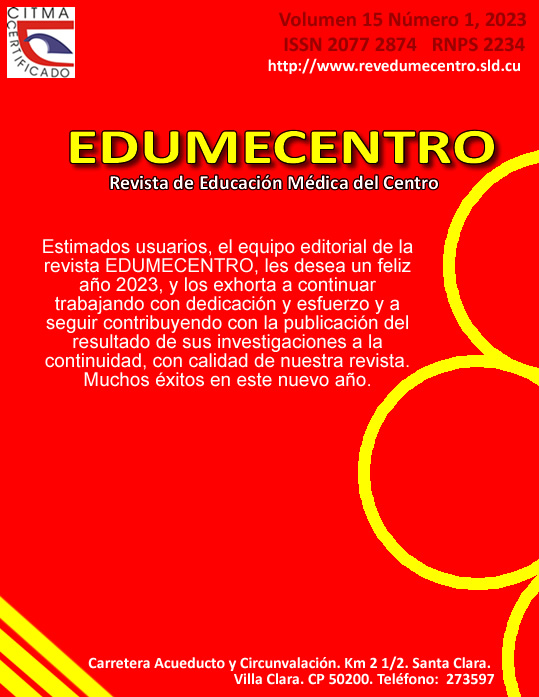Use of simulators in Obstetrics students. Alas Peruanas University of Metropolitan Lima, Peru
Keywords:
training, medical informatics applications, learning, professional development, education, medicalAbstract
Background: education in the health field is constantly improving as a result of technological advances. Simulators represent a very useful tool, especially in the Obstetrics career, since they allow the acquisition of skills on childbirth care in a safe environment.
Objective: to describe the use of simulators in Obstetrics students at the Alas Peruanas university in Metropolitan Lima, Peru.
Methods: non-experimental, descriptive, cross-sectional design study, from June to July 2020, based on the theoretical methods of analysis-synthesis and induction-deduction and as an empirical method, a 20-item questionnaire was applied by the authors.
Results: 76.2 % (n=61) of the Obstetrics interns have used the simulator at least once during their academic training; the most used were those corresponding to delivery care (85.2%) and Leopold's maneuvers (77.1 %), while the least used were attachment (49.2 %) and Kardex (52.5 %). 60 % of students considered that the use of simulators improved their abilities in the degree.
Conclusions: there is an unequal use of simulators among Obstetrics students, although their usefulness is positively assessed.
Downloads
References
1. Matzumura JP, León HM, Gutiérrez HF. Simulación clínica y quirúrgica en la educación médica: aplicación en Obstetricia y ginecología. Rev Peruana de Ginecología y Obstetricia [Internet]. 2018 [citado 16/04/2023];64(2):[aprox. 10 p.]. Disponible en: http://dx.doi.org/https://doi.org/10.31403/rpgo.v64i2084
2. Knobel R, Menezes MDO, Santos DDS, Takemoto MLS. Planificación, construcción y uso de simuladores artesanales para mejorar la enseñanza y el aprendizaje de la Obstetricia. Rev Latino Americana de Enfermagem [Internet]. 2020 [citado 16/04/2023];28:e3302. Disponible en: https://doi.org/10.1590/1518-8345.3684.3302
3. Siaulys MM, da Cunha LB, Torloni MR, Kondo MM. Obstetric emergency simulation training course: experience of a private-public partnership in Brazil. Reproductive health [Internet]. 2019 [citado 16/04/2023];16(1):[aprox. 8 p.]. Disponible en: https://doi.org/10.1186/s12978-019-0689-6
4. Corvetto M, Bravo M, Montaña R, Utili F, Escudero E, Dagnino J, et al. Simulación en Educación médica una sinopsis. Rev Med Chile [Internet]. 2013 [citado 16/04/2023];141:[aprox. 10 p.]. Disponible en: http://dx.doi.org/10.4067/S0034-98872013000100010
5. Dahlberg J, Nelson M, Dahlgren MA, Blomberg M. Ten years of simulation-based shoulder dystocia training-impact on obstetric outcome, clinical management, staff confidence, and the pedagogical practice-a time series study. BMC Pregnancy and Childbirth [Internet]. 2018 [citado 16/04/2023];18(1):[aprox. 8 p.]. Disponible en: https://doi.org/10.1186/s12884-018-2001-0
6. Nippita S, Haviland MJ, Voit SF, Perez J, Hacker MR, Paul ME. Randomized trial of high-and low-fidelity simulation to teach intrauterine contraception placement. American J of Obstetrics and Gynecology [Internet]. 2018 [citado 16/04/2023];218(2):258.e1–258.e11. Disponible en: https://doi.org/10.1016/j.ajog.2017.11.553
7. Ramseyer AM, Lutgendorf MA. Implementation of Low-Cost Obstetric Hemorrhage Simulation Training Models for Resident Education. Military Medicine [Internet]. 2019 [citado 16/04/2023];184 (11-12):e637–e641. Disponible en: https://doi.org/10.1093/milmed/usz098
8. Murthy SS, Ntakiyiruta G, Ntirenganya F, Ingabire A, Defregger SK, Reznor G, et al. A Randomized Cross-Over Trial Focused on Clinical Breast Exam Skill Acquisition Using High Fidelity versus Low Fidelity Simulation Models in Rwanda. J of Surgical Education [Internet]. 2020 [citado 16/04/2023];77(5):[aprox. 8 p.]. Disponible en: https://doi.org/10.1016/j.jsurg.2020.02.030
9. Baltodano F, Pineda I, Chiluisa P, Espín M, Damián A, Oñate C. Uso de simuladores de miembro superior para aprendizaje de técnica de cateterización venosa periférica. La ciencia al servicio de la salud [Internet]. 2020 [citado 16/04/2023];11(1):[aprox. 9 p.]. Disponible en: http://dx.doi.org/10.47244/cssn.Vol11.Iss1.466
10. Rivera FP, Valenzuela M, Carvajal J. Enseñanza de la atención del parto vaginal utilizando simuladores. ARS MEDICA [Internet]. 2018 [citado 16/04/2023];43(2):[aprox. 7 p.]. Disponible en: https://doi.org/10.11565/arsmed.v43i2.1282
11. Crofts JF, Bartlett C, Ellis D, Hunt LP, Fox R, Draycott TJ. Training for shoulder dystocia: a trial of simulation using low-fidelity and high-fidelity mannequins. Obstetrics and Gynecology [Internet]. 2006 [citado 16/04/2023];108(6):[aprox. 10 p.]. Disponible en: https://doi.org/10.1097/01.AOG.0000246801.45977.c8
12. Altamirano JE. La simulación clínica: Un aporte para la enseñanza y aprendizaje en el área de Obstetricia. Rev Electrónica Educare [Internet]. 2019 [citado 16/04/2023];23(2):[aprox. 11 p.]. Disponible en: http://dx.doi.org/10.15359/ree.23-2.9
13. Alvites CG. Metodología de simulación: simulador baby real care II en el proceso de enseñanza aprendizaje. HAMUT'AY [Internet]. 2014 [citado 16/04/2023];1(2):[aprox. 9 p.]. Disponible en: https://dialnet.unirioja.es/descarga/articulo/5665693.pdf
14. Sawyer T, Stavroudis TA, Ades A, Dadiz R, Dammann C, Halamek LP, et al. Simulation in Neonatal-Perinatal Medicine Fellowship Programs. American J of Perinatology [Internet]. 2020 [citado 16/04/2023];37(12):[aprox. 6 p.]. Disponible en: https://doi.org/10.1055/s-0039-1693465
15. Martínez L, González M. Uso del simulador clínico para el aprendizaje de contenidos procedimentales en enfermería. Rev Facultad de Ciencias de la Salud UDES [Internet]. 2017 [citado 16/04/2023];4(1):[aprox. 7 p.]. Disponible en: http://dx.doi.org/10.20320/rfcsudes.v4i1.104
16. Nitsche J, Morris D, Shumard K, Akoma U. Vaginal delivery simulation in the Obstetrics and Gynaecology clerkship. The Clinical Teacher [Internet]. 2016 [citado 16/04/2023];13(5):[aprox. 6 p.]. Disponible en: https://doi.org/10.1111/tct.12458
17. Rose K, Jensen K, Guo R, Afshar Y. Simulation to Improve Trainee Skill and Comfort with Forceps-Assisted Vaginal Deliveries. AJP Reports [Internet]. 2019 [citado 16/04/2023];9(1):e6–e9. Disponible en: https://doi.org/10.1055/s-0039-1677736
18. Baeza MA, Mella J, Soldati A, Escuelero E, Tapia A, Arraztoa JA. Aplicabilidad de simuladores de mediana complejidad en el proceso de formación de residentes de Ginecología y Obstetricia. Rev Chil Obstet Ginecol [Internet]. 2010 [citado 16/04/2023];75(6):[aprox. 7 p.]. Disponible en: http://dx.doi.org/10.4067/S0717-75262010000600002
Published
How to Cite
Issue
Section
License
Los autores que publican en esta revista están de acuerdo con los siguientes términos:- Los autores/as conservarán sus derechos de autor y ceden a la revista el derecho de primera publicación de su obra, el cuál estará simultáneamente sujeto a una Licencia Creative Commons Reconocimiento-NoComercial-CompartirIgual 4.0 Internacional (CC BY-NC-SA 4.0) que permite a terceros compartir la obra siempre que se indique su autor y su primera publicación esta revista.
- Los autores pueden establecer por separado acuerdos adicionales para la distribución no exclusiva de la versión de la obra publicada en la revista (por ejemplo, situarlo en un repositorio institucional o publicarlo en un libro), con un reconocimiento de su publicación inicial en esta revista.
- Se permite y se anima a los autores a difundir sus trabajos electrónicamente (por ejemplo, en repositorios institucionales o en su propio sitio web) antes y durante el proceso de envío, ya que puede dar lugar a intercambios productivos, así como a una citación más temprana y mayor de los trabajos publicados (Véase The Effect of Open Access) (en inglés).










